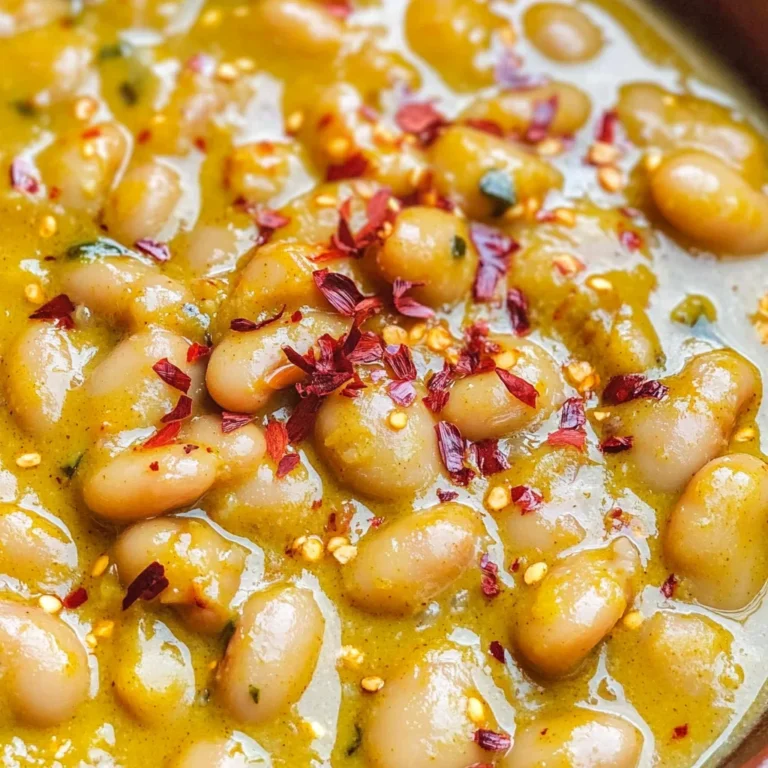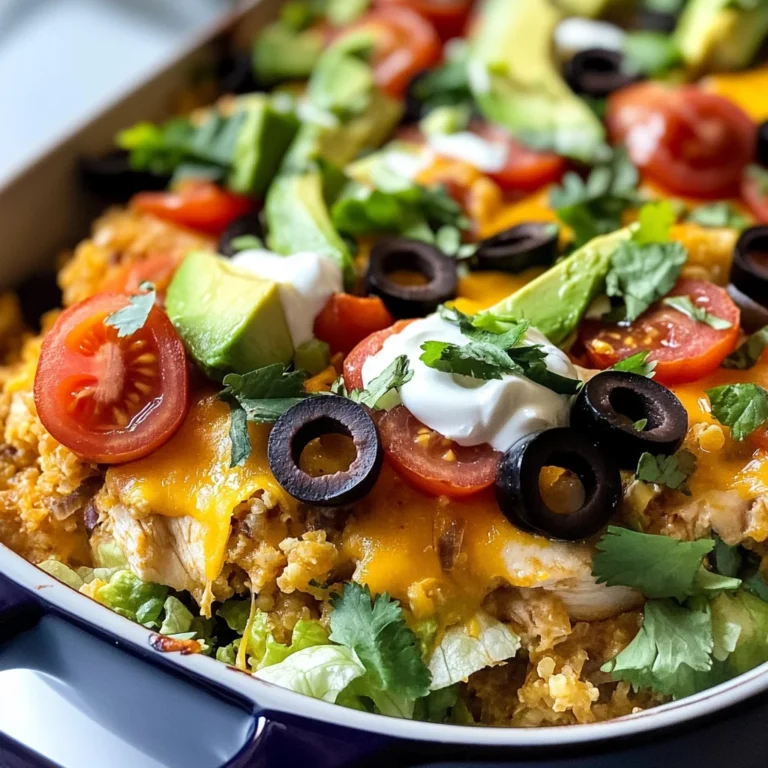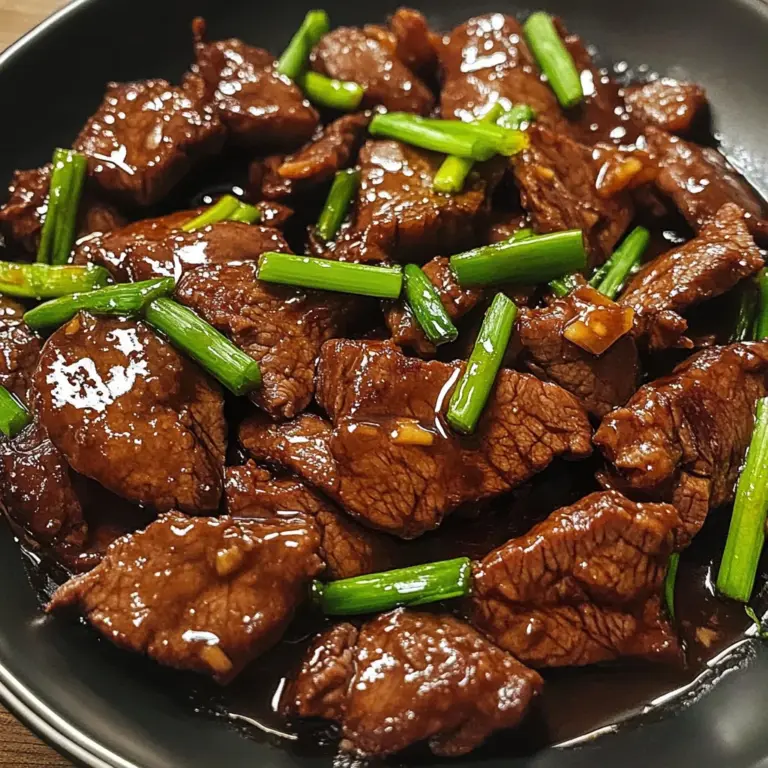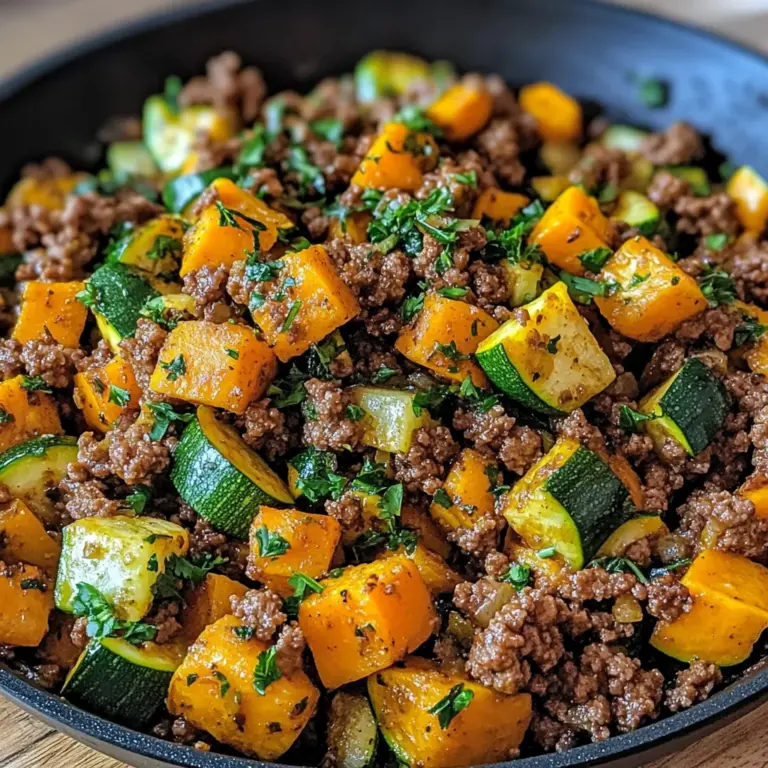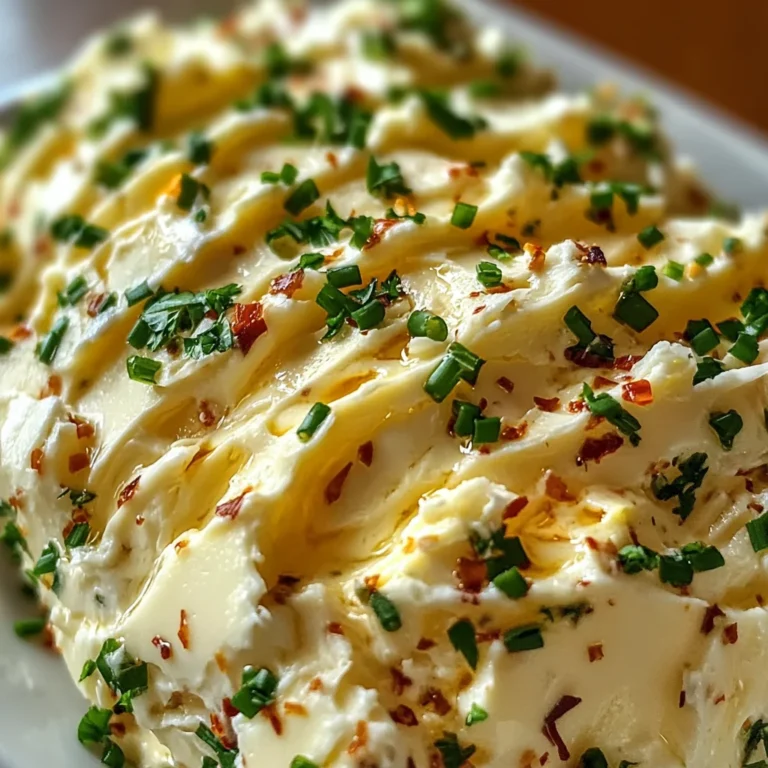Butternut Squash Pasta Sauce
A creamy vegan butternut squash pasta sauce is a delightful dish that brings warmth and comfort to any meal. Ideal for weeknight dinners or special occasions, this sauce is made with simple, healthy ingredients. Its rich flavors and smooth texture make it a standout choice for pasta lovers looking for a nutritious alternative. Enjoy it over your favorite pasta and savor the deliciousness of seasonal squash!
Why You’ll Love This Recipe
- Quick to Prepare: This recipe takes just 30 minutes, perfect for busy weekdays.
- Healthy Ingredients: Packed with nutrients from butternut squash and tomatoes, it’s guilt-free indulgence.
- Vegan-Friendly: Enjoy a creamy sauce without any animal products, making it suitable for various diets.
- Versatile Use: Pair it with any pasta or use as a dip for breadsticks and veggies.
- Flavorful & Satisfying: The combination of spices and roasted vegetables creates an irresistible taste.
Tools and Preparation
Before you dive into making your butternut squash pasta sauce, gather your essential kitchen tools. Having the right equipment will simplify the cooking process and help you achieve the best results.
Essential Tools and Equipment
- Baking sheet
- Blender
- Parchment paper
- Pot for boiling pasta
Importance of Each Tool
- Baking sheet: Essential for roasting the vegetables evenly, ensuring they develop great flavor.
- Blender: Creates a smooth sauce by blending roasted veggies with pasta water to achieve the perfect consistency.

Ingredients
A creamy vegan butternut squash pasta sauce made with simple healthy ingredients.
For the Sauce
- 16 oz bag of frozen diced butternut squash
- 1.5 cups fresh chopped tomatoes
- 1/2 yellow onion
- 2 tbsp olive oil
- 1 tsp salt
- 1/4 tsp black pepper
- 1/2 tsp dried thyme
For the Pasta
- 1 lb pasta
- 1/3 cup pasta water reserved from cooked pasta
How to Make Butternut Squash Pasta Sauce
Step 1: Preheat the Oven
Preheat your oven to 450°F (232°C) and prepare a baking sheet by lining it with parchment paper.
Step 2: Prepare Vegetables
Place the frozen cubed butternut squash, chopped tomatoes, and sliced onion on the baking sheet.
Step 3: Season
Drizzle olive oil over the veggies and season with salt, black pepper, and dried thyme.
Step 4: Mix Ingredients
Mix everything together to ensure that all vegetables are evenly coated in oil and seasonings.
Step 5: Roast
Bake at 450°F (232°C) for 20 minutes until vegetables are tender and lightly caramelized.
Step 6: Cook Pasta
While the veggies roast, cook your chosen pasta according to package instructions until al dente.
Step 7: Reserve Pasta Water
Before draining the cooked pasta, remember to reserve about 1/3 cup of the starchy pasta water.
Step 8: Blend Sauce
Take out the hot roasted vegetables from the oven and transfer them into a blender. Add in the reserved pasta water. Blend until you achieve a smooth sauce.
Step 9: Combine
Pour the creamy butternut squash sauce over the drained pasta and toss gently to coat every strand.
Step 10: Serve
Serve immediately with grated parmesan cheese or plant-based parmesan for a delightful finish!
How to Serve Butternut Squash Pasta Sauce
Serving butternut squash pasta sauce offers many delightful options. This creamy, vegan sauce complements a variety of dishes and can be adapted to suit your taste.
Toss with Fresh Vegetables
- Add sautéed spinach, kale, or broccoli for a colorful and nutritious meal.
Top with Nuts or Seeds
- Sprinkle roasted pine nuts or sunflower seeds on top for added crunch and flavor.
Pair with Protein
- Serve alongside grilled chicken or turkey for a heartier dinner option.
Mix in Greens
- Stir in arugula or fresh basil for an aromatic touch that enhances the dish.
Use as a Dip
- Serve the sauce as a dip with whole-grain crackers or fresh vegetable sticks.
Drizzle with Balsamic Reduction
- A balsamic glaze adds a tangy sweetness that balances the creaminess of the sauce.
How to Perfect Butternut Squash Pasta Sauce
To ensure your butternut squash pasta sauce is creamy and flavorful, follow these helpful tips.
- Use Fresh Ingredients: Fresh tomatoes and onions enhance the overall flavor profile of your sauce.
- Blend Until Smooth: Ensure you blend the baked vegetables thoroughly for a silky texture without chunks.
- Adjust Seasoning: Taste your sauce before serving; add more salt, pepper, or herbs if needed.
- Reserve Pasta Water: The starchy pasta water helps to create a velvety consistency when mixing with the sauce.
- Experiment with Spices: Feel free to add spices like nutmeg or cinnamon for added warmth and depth.
- Serve Immediately: For the best flavor and texture, serve your dish right after preparation.
Best Side Dishes for Butternut Squash Pasta Sauce
Pairing side dishes with butternut squash pasta sauce can elevate your meal. Here are some perfect complements to consider.
- Garlic Bread: Crispy garlic bread is great for scooping up any leftover sauce.
- Mixed Green Salad: A light salad with vinaigrette provides a refreshing contrast to the creamy pasta.
- Roasted Brussels Sprouts: These add a deliciously crispy element that pairs well with the sauce’s smoothness.
- Grilled Asparagus: The slight char from grilling enhances the flavor, making it an excellent side choice.
- Stuffed Bell Peppers: Fill bell peppers with grains and beans for a protein-rich dish alongside your pasta.
- Quinoa Salad: A cold quinoa salad mixed with veggies can add a healthy grain option next to your meal.
- Zucchini Noodles: Lightly sautéed zucchini noodles provide an additional veggie intake while being low-carb.
- Herbed Rice Pilaf: Fluffy rice pilaf flavored with herbs makes for an aromatic side that complements butternut squash perfectly.
Common Mistakes to Avoid
Making butternut squash pasta sauce can be simple, but there are common pitfalls that may affect the outcome. Here are some mistakes to watch out for:
- Skipping the seasoning – Not adding enough salt or pepper can make your sauce bland. Always taste and adjust seasonings before serving.
- Overcooking vegetables – Baking the veggies too long can lead to a mushy texture. Stick to the recommended baking time to keep them roasted but firm.
- Not reserving pasta water – Forgetting to save the pasta water means missing out on a creamy texture. Always reserve some before draining your pasta.
- Blending while too hot – Blending hot ingredients can cause splattering. Allow the roasted vegetables to cool slightly before blending for safety and ease.
- Using unripe tomatoes – Unripe tomatoes lack flavor and acidity. Choose ripe, fresh tomatoes for a more vibrant sauce.
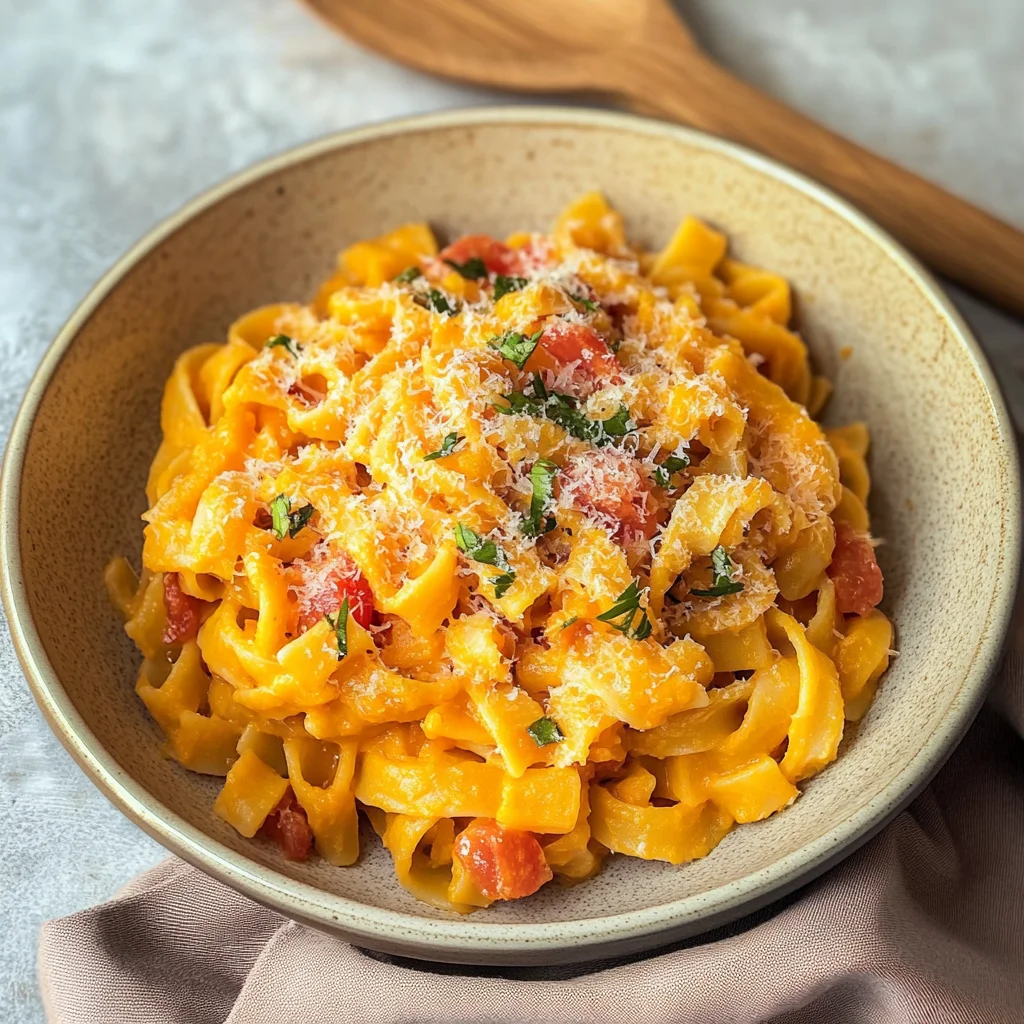
Storage & Reheating Instructions
Refrigerator Storage
- Store leftover butternut squash pasta sauce in an airtight container.
- It will last for up to 4 days in the refrigerator.
Freezing Butternut Squash Pasta Sauce
- Freeze in freezer-safe containers or bags for up to 3 months.
- Label containers with the date for easy tracking.
Reheating Butternut Squash Pasta Sauce
- Oven – Preheat to 350°F and heat sauce in an oven-safe dish covered with foil until warm.
- Microwave – Heat in short intervals, stirring frequently until heated through.
- Stovetop – Warm over low heat, stirring occasionally, until hot.
Frequently Asked Questions
Here are some common questions about butternut squash pasta sauce.
How do I make Butternut Squash Pasta Sauce creamier?
Adding a splash of vegetable broth or dairy-free cream can enhance creaminess while keeping it vegan.
Can I use fresh butternut squash instead of frozen?
Yes, fresh butternut squash works well! Just peel, cube, and roast it like the frozen variety.
What pasta pairs best with Butternut Squash Pasta Sauce?
Pasta shapes like penne or fusilli hold onto the sauce nicely, making every bite flavorful.
How do I customize this Butternut Squash Pasta Sauce?
Feel free to add spices like nutmeg or herbs such as basil for different flavor profiles. You can also mix in sautéed greens or roasted vegetables.
Final Thoughts
This creamy butternut squash pasta sauce is not only delicious but also versatile. It pairs wonderfully with various pastas and can be customized with your favorite herbs and veggies. Give it a try; it’s an easy way to elevate your dinner!
Creamy Butternut Squash Pasta Sauce
This creamy butternut squash pasta sauce is the perfect blend of comfort and nutrition, ideal for weeknight dinners or special occasions. Made with wholesome ingredients, this vegan sauce boasts a rich texture and delightful flavors that will please pasta lovers of all kinds. The sweetness of roasted butternut squash combines beautifully with tomatoes and aromatic herbs to create a dish that’s both satisfying and guilt-free. Serve it over your favorite pasta or use it as a dip for veggies – it’s incredibly versatile! Enjoy the warmth of seasonal squash in every bite.
- Prep Time: 10 minutes
- Cook Time: 30 minutes
- Total Time: 40 minutes
- Yield: Approximately 4 servings 1x
- Category: Dinner
- Method: Baking
- Cuisine: Vegan
Ingredients
- 16 oz frozen diced butternut squash
- 1.5 cups fresh chopped tomatoes
- 0.5 yellow onion
- 2 tbsp olive oil
- 1 tsp salt
- 0.25 tsp black pepper
- 0.5 tsp dried thyme
- 1 lb pasta
- 0.33 cup reserved pasta water
Instructions
- Preheat your oven to 450°F (232°C) and line a baking sheet with parchment paper.
- Spread frozen butternut squash, chopped tomatoes, and sliced onion on the baking sheet.
- Drizzle with olive oil, sprinkle salt, black pepper, and dried thyme; mix well.
- Roast for 20 minutes until tender and lightly caramelized.
- Cook pasta according to package instructions; reserve about 0.33 cup pasta water before draining.
- Blend the roasted vegetables with reserved pasta water until smooth.
- Mix the creamy sauce with cooked pasta and serve immediately.
Nutrition
- Serving Size: 1 cup (250g)
- Calories: 215
- Sugar: 6g
- Sodium: 360mg
- Fat: 7g
- Saturated Fat: 1g
- Unsaturated Fat: 6g
- Trans Fat: 0g
- Carbohydrates: 36g
- Fiber: 6g
- Protein: 5g
- Cholesterol: 0mg


